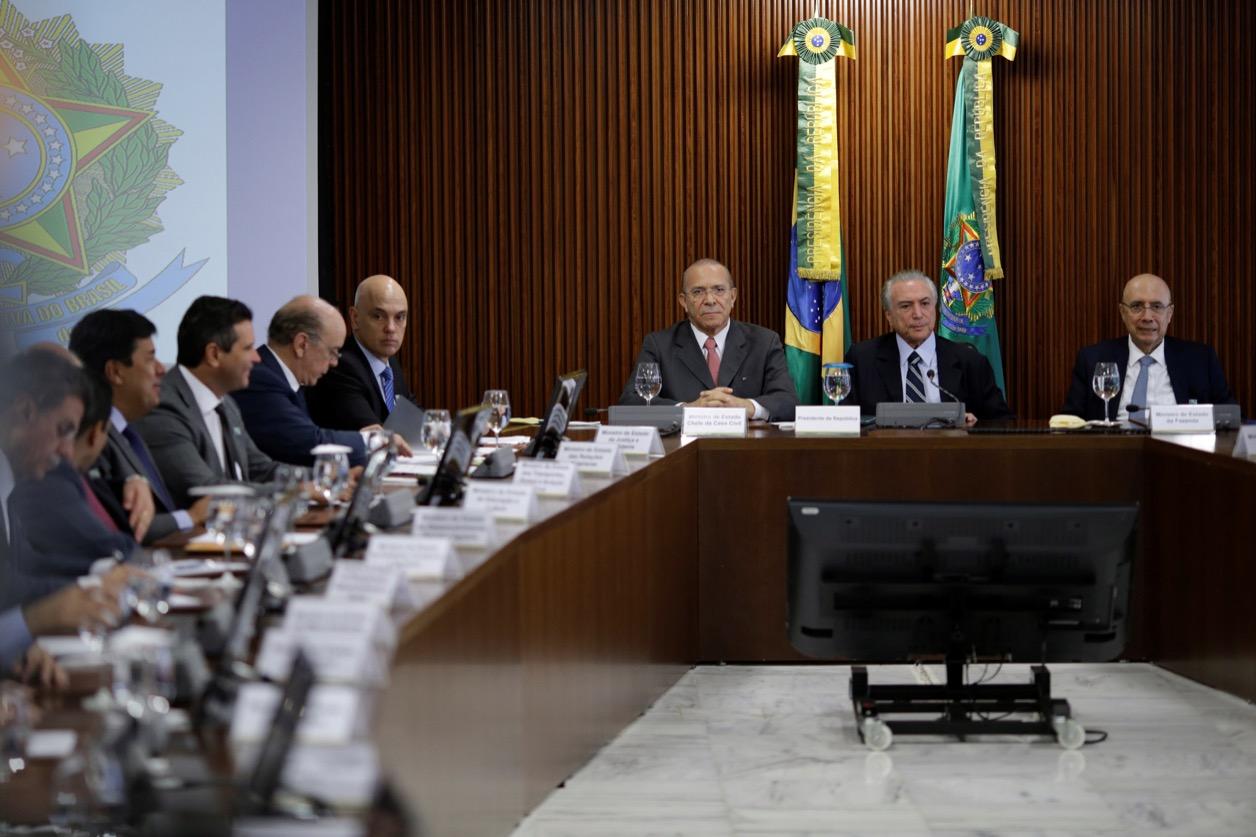Here’s why Brazil’s new cabinet is all men
Brazil's Chief of Staff Eliseu Padilha, interim President Michel Temer, Finance Minister Henrique Meirelles are seen during the first ministerial meeting at the Planalto Palace in Brasilia, Brazil, May 13, 2016.
Many Brazilians don’t know much about their new acting president, Michel Temer. The 75-year-old former constitutional lawyer is mostly famous here for being married to a 32-year-old former beauty queen, rather than for any momentous political accomplishments.
But the public has learned at least one thing about him in his first few hours in the presidency: He doesn’t seem too concerned about representing the people he governs. On Thursday, Temer announced his new cabinet — and they’re all men:
That is pretty extraordinary. In 2016, governments across the world are making at least some effort to be more representative. Canada’s new prime minister recently announced a 50 percent female cabinet. According to the United Nations, 22 percent of all legislators worldwide are now female, up from just 11 percent in 1993.
At first glance, Temer’s rejection of this trend seems to say a lot about his views on women. But Brazilian political scientists say it also likely reflects the political reality he is facing. Temer wasn’t elected president by the Brazilian public, 51 percent of whom are women. Rather, he was effectively installed by Congress, via the impeachment process against Dilma Rousseff, which on Thursday removed her from office for up to 180 days. If you take this into account, the new cabinet is representative of the body that put him into power: Brazil’s Congress is 90 percent male.
“This cabinet is basically Temer repaying favors,” said Mauricio Santoro, a professor and political scientist in Rio. “Who is represented? Congress and industry and agriculture — the people who made him president.”
That may be the case, but the all-male, racially homogenous cabinet isn’t cutting it with many women. And Rousseff herself, who previously had four female ministers, condemned Temer’s choices on Friday:
"I'm sorry that there are no women or blacks in the new cabinet," Rousseff said, according to the TeleSur news network.
Nadine Gasman, the United Nations Women representative in Brazil, said regardless of his political fealties, Temer has a duty to represent all the people of his country. By appointing all male, primarily white ministers, the acting president is sending a clear message to women and non-whites about where his priorities stand, she said.
“What’s very worrisome is that a cabinet of 22 men think that they can govern for 100 percent of the population without having the voices, the presence, not only of women but of black people,” Gasman said.
Temer faces numerous challenges as interim head of state. Probably chief among them is the need to reverse Brazil’s hemorrhaging economy. Economists forecast the country’s GDP to sink almost 4 percent in 2016 for the second year in a row.
The New York Times reported Thursday that Temer considered at least “a couple” of women for cabinet positions, but that neither made the grade.
Gasman said Temer’s best chance of reversing the country’s fortunes would have been to pick a diverse team rather than reverting to a homogeneity not seen in Brazil in decades.
“This idea is so patriarchal and so sexist, that men believe they can solve the problems of all,” she said. “We have evidence from around the world that shows that cabinets that are more plural and more representative are more efficient and more effective.”
Sonia Correa, who coordinates the project Sexuality Policy Watch, said the lack of women in the new cabinet is just the most visible element of Temer’s dismantling of public programs that have contributed to gender and racial equality.
She pointed to other changes by the interim leader — the abolition of the Ministry of Women, Racial Equality and Human Rights, and the incorporation of the Ministry of Culture into the Ministry of Education — as evidence that Temer plans to roll back years of gains for Brazilian cultural diversity and the promotion of human rights.
While the all-male cabinet is cause for concern for rights activists, it’s not as if women were faring particularly well under their first female president, either.
This remains a society where male chauvinism is common, one in which a lawmaker can tell a female colleague that she’s “not worth raping” and still get handily re-elected. A recent study showed that homicides against women in Brazil increased by 21 percent between 2003 and 2013.
Women’s rights groups have organized demonstrations across the country in recent months, protesting harsh new proposed abortion laws and attempting to send a message to Brasilia that women are a powerful force in this country’s politics.
The rising influence of such groups is a political reality that Temer and his allies had better wake up to, said Santoro, the political scientist.
“Social movements have so much power here now,” he said. “Women have more and more power. These social movements weren’t enough to keep Dilma in office, but they can make Temer’s life hell over the next six months with roadblocks and strikes and other actions.”
